calsfoundation@cals.org
Plum Bayou Project
The Plum Bayou Project was part of a New Deal plan designed to help rural residents receive federal relief and assistance during the economic crisis of the 1930s. Located approximately seventeen miles north of Pine Bluff (Jefferson County), Plum Bayou was one of several similar communities built in the Arkansas Delta.
During the Great Depression, the federal Resettlement Administration—later the Farm Security Administration (FSA)—experimented with programs designed to give assistance to rural farm families. Rexford G. Tugwell, head of the Resettlement Administration, believed that sending farmers into the cities with no job prospects was an untenable situation and certainly no answer to the farmers’ desperate plight. Instead, he focused on developing resettlement projects designed to move farmers barely surviving on marginal land to more fertile soil better suited for crops such as cotton. The Resettlement Administration’s goal was to allow farmers the opportunity to own property instead of renting or sharecropping and to buy the livestock and equipment necessary to work the land properly.
Typically, the land for the housing projects was purchased by the Resettlement Administration, and, within a year, construction of various buildings began, including houses for the incoming residents. Established in 1935 and officially opened in 1936, Plum Bayou consisted of nearly 10,000 acres of highly fertile farmland obtained at a cost of $386,000. Approximately $900,000 was spent for additional development. Plum Bayou was available for use by 183 selected families. The project consisted of approximately thirty to forty acres of land per farmer, planted mostly in cotton, though some feed crops were also produced. This small amount of acreage led to problematic farming for the settlers—too little land to provide adequate income while allowing the concentration of as many poor rural families as possible. Plum Bayou families realized only $466 income per farm, a factor directly related to the small plots and the inability to mechanize in the fashion of larger farms and wealthier planters.
Plum Bayou’s houses came equipped with electrical wiring, light fixtures, running water, and outdoor plumbing. In addition, each place had its own well, a barn, and a small pasture. When home construction was completed in 1937, 100 houses had been built by the Resettlement Administration. The homes also had some furnishings, such as refrigerators instead of iceboxes. Most residents brought their own furniture to their new homes—beds, sofas, tables, and such—although many felt that their dilapidated possessions did not live up to their new standard of living. New furniture purchases often exceeded the families’ earnings and helped to contribute to additional debt. Overall, most of the resettled families in Plum Bayou felt that their living conditions improved significantly from their previous situations. Additionally, the FSA’s project contributed to a semblance of job security and a feeling of belonging to a community that many people did not have as sharecroppers or renters.
Taking up residence at Plum Bayou was not automatically guaranteed. Selection for settlement at Plum Bayou meant meeting specific criteria in order to be accepted into the community. One important element was race—Plum Bayou was for white farmers only. A separate facility located at Lake View near Helena (Phillips County) was provided for black families. Most of the families were relatively young (with heads of household between twenty-five and forty-five years of age), had previous agricultural experience, and could provide some basic tools to start farming. Unlike with other Arkansas projects, none of the Plum Bayou residents received federal relief payments prior to being selected for resettlement.
As with the other resettlement programs, each farmer received government loans to pay for seed, food, and clothing. In return, the family was obliged to cooperate with a financial plan that included rent and loan payments. Working with a specific budget seemed to be a first-time occurrence for many of the Plum Bayou residents. After a five-year period, farmers could option the land they occupied and take up to forty years to pay off the mortgage.
Plum Bayou rapidly expanded and added a community center rivaling that found at the Dyess Colony in Mississippi County. A school soon appeared with a gym, library, and vocational facilities serving grades four through twelve. Younger students attended a separate nearby school.
By 1942, the effects of rapid expansion began to be felt in the community. Serious financial difficulties developed for the Plum Bayou Project as a result of low gin operations and farmers unable or unwilling to pay their debts. The FSA made plans to begin selling off Plum Bayou’s assets, including individual homes. In 1945, the Plum Bayou Cooperative Association purchased the cotton gin, store, feed mill, and other service buildings from the government. However, low cotton prices at the end of World War II meant that the co-op could not afford the payments. In 1946, the FSA officially became part of the Farmers Home Administration. Today, what remains of Plum Bayou consists of a few original settlers who have managed to merge their original plots with adjoining properties and have become successful Arkansas rice farmers.
For additional information:
Clawson, Marion. “The Resettlement Experience on Nine Selected Resettlement Projects.” Agricultural History 52 (January 1978): 1–92.
Holley, Donald. Uncle Sam’s Farmers: The New Deal Communities in the Lower Mississippi Valley. Urbana: University of Illinois Press, 1975.
Leighninger, Robert D., Jr. Long-Range Public Investment: The Forgotten Legacy of the New Deal. Columbia: University of South Carolina Press, 2007.
Wallis, Ernestine.“Lake Dick and Plum Bayou New Deal Projects in Jefferson County.” Jefferson County Historical Quarterly 41 (March 2013): 29–35.
Marjorie J. Hunter
West Memphis High School
 Women
Women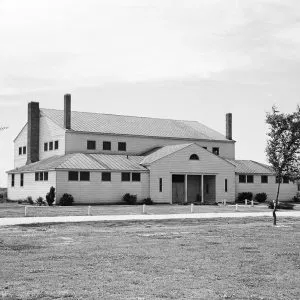 Plum Bayou Buildings
Plum Bayou Buildings  Plum Bayou Flood
Plum Bayou Flood 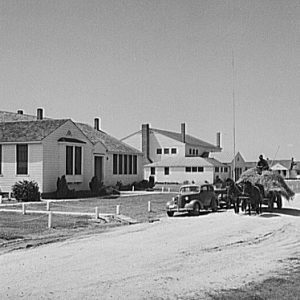 Plum Bayou Project Buildings
Plum Bayou Project Buildings 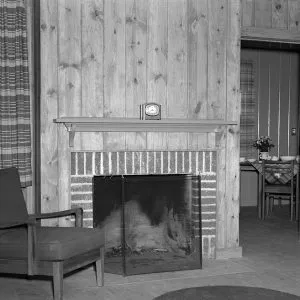 Plum Bayou Project House
Plum Bayou Project House 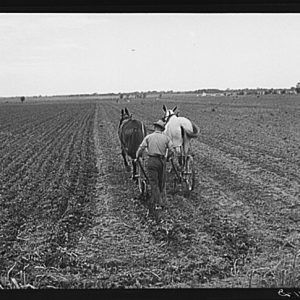 Plum Bayou Project Farmer
Plum Bayou Project Farmer  Plum Bayou Project Buildings
Plum Bayou Project Buildings 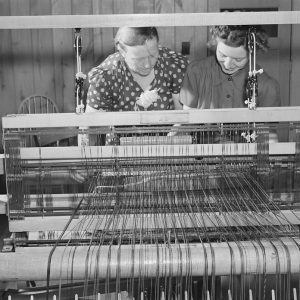 Weaving Instruction
Weaving Instruction 



Comments
No comments on this entry yet.